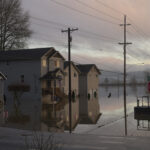Powerful earthquakes may be a trigger for weakening geologic faults a half a world away, U.S. researchers said this week in a study that points to new ways to predict earthquakes.
“Earthquakes are caused when a fault fails, either because of the build-up of stress or because of a weakening of the fault,” said earthquake researcher Taka’aki Taira, formerly of the Carnegie Institution in Washington and now of the University of California Berkeley.
Taira’s team analyzed 20 years of seismic data from the Parkfield area of California’s San Andreas fault.
They noticed areas of fluid-filled cracks along the fault appeared to shift from time to time — often after large, far-away earthquakes, such as the 2004 Sumatra-Andaman Earthquake.
“We speculate that changes we see at Parkfield could be happening in many places in the world,” Taira said in a telephone interview.
He said his team plans to gather data from other fault zones to see if they detect the same pattern of changes.
The researchers will also for changes at Parkfield to see if they can detect a significant impact from recent powerful earthquakes this week in Samoa and on Indonesia’s Sumatra island.
SUBTLE CHANGES
For the study, Taira’s team used motion-sensing equipment called seismometers bored into the Earth’s crust to detect subtle changes in earthquake waves.
They noticed that when fluid levels changed in cracks along the fault, repeating earthquakes that occur in the fault zone got smaller, but more frequent — a sign the fault was getting weaker.
“The total displacement of the fluids is only about 10 meters (30 feet) at a depth of about three kilometers (1.8 miles), so it takes very sensitive seismometers to detect the changes,” Fenglin Niu of Rice University in Texas, who worked on the study, said in a statement.
He said that movement of the fluid in these cracks appears to lubricate the fault zone, weakening the fault.
Taira and colleagues think that by monitoring changes in fluids that fill up cracks near fault lines, they may be able to predict when faults are growing weaker, offering a way to predict earthquakes.
Changes in fault strength are much harder to measure than changes in stress, especially for faults deep in the Earth’s crust, he said.
“Our result opens up exciting possibilities for monitoring seismic risk and understanding the causes of earthquakes,” Taira said.
Was this article valuable?
Here are more articles you may enjoy.

 Pacific Northwest Braces for Even More Flooding Rain This Week
Pacific Northwest Braces for Even More Flooding Rain This Week  Marijuana’s Move to Schedule III: What it Really Means for Cannabis Insurance
Marijuana’s Move to Schedule III: What it Really Means for Cannabis Insurance  NYT Asks Judge to Dismiss Trump’s ‘Implausible’ Defamation Suit
NYT Asks Judge to Dismiss Trump’s ‘Implausible’ Defamation Suit  Tesla Drivers Are Buying Escape Tools and Cars to Avoid Getting Trapped Inside
Tesla Drivers Are Buying Escape Tools and Cars to Avoid Getting Trapped Inside 